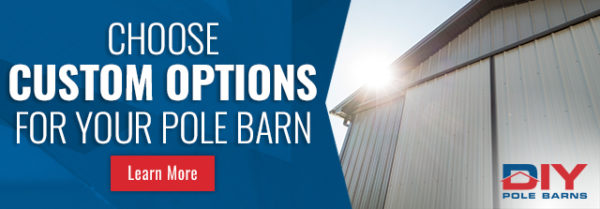Heating and cooling your pole barn is important whether it’s a home for your Mustang with four tires or four hooves and a tail. There are many things to consider while planning your pole barn to help control the temperature throughout the year. Planning for heating and cooling ahead of time will help ensure the most stable environment to keep everything from saw horses to quarter horses comfortable.
Benefits of Temperature Control
Temperature control is important for animal barns, especially in the hot summer months. Poor ventilation can lead to air quality issues and overheating which can be dangerous for animals. Winter months may not be as critical, as horses are generally okay with colder weather.
Controlling the temperature helps keep hobby/workshop pole barns comfortable and good ventilation can prevent “pole barn sweating” or condensation that can lead to rusty tools and a myriad of other moisture issues.
Heating a Pole Barn
Your intended use and your budget will help you determine the best heating option for your pole barn. Radiant heating can either be overhead or in-floor. Both of these options heat objects, not the air, and are good choice for high traffic areas. In-floor heating tends to take longer to heat up, but heat is retained for a longer period of time. So, when you open the door to walk out, all the hot air doesn’t escape with you.
Pellet stoves are an effective source of heat and economical as well. Keep in mind that some areas restrict wood-burning appliances, so check your local building codes prior to installing.
A forced air furnace is an option as well. This choice requires ductwork, as in most homes, so consider the size and usage of your pole barn.
Cooling a Pole Barn
Air conditioning may be the ticket for your workshop, studio or man cave. Window units can cool a small section or, for larger spaces, an air conditioning system that utilizes the duct work from a forced air furnace may be the solution.
Cooling options for pole barns range from fans to air conditioning. For animal barns, A/C units are not generally necessary if ventilated properly. Misting or spraying systems are highly effective not only in keeping the temperature down, but keep dust and irritants down as well. Coupled with ground or mounted fans to aid evaporation, these options can keep your barn – and its occupants – quite comfortable when it’s hot outside.
Ventilation is Key
The most important part of any barn is ventilation. If properly ventilated, the temperature is more easily controlled, the air quality will be good for you and/or your animals and the building itself can breathe and reduce condensation that can lead to moisture issues.
Pole barns from DIY Pole Barns offer several ventilation options:
Vented Soffit
This is utilized along with the 12″ overhang to allow fresh air to enter the pole barn. The perforated soffit panels aid in overall ventilation and the reduction of condensation. Be sure to add this in barns housing livestock and barns that will have a ceiling in them.
Continuous Ridge Vent
These breathable strips contour to the ribs of the roof to seal the gap at the top of the roof caused by the rib pattern of the metal roofing. This will aid in overall ventilation and the reduction of condensation. Be sure to add this in barns housing livestock and barns that will have a ceiling in them.
Cupola with Weathervane
These classic additions are as functional as they are beautiful. Not only will they help circulate air, but they will add a touch of class to you pole barn. We even offer an assortment of weathervanes to personalize your building at no additional cost.
Ventilation not only helps regulate temperature, it prevents dirty air from accumulating in your pole barn. This is critical for horse and animal barns.
Fans
While it is true that opening doors and windows does increase ventilation, fans are necessary for barns that don’t get natural air flow. Fans should be positioned to move air through the barn and continuously circulate air. Ceiling fans are a popular solution to keep air moving. If yours is an animal barn and you decide to install ceiling fans, be sure they are high enough – approximately 11-12 feet – to avoid animal contact. The direction of rotation can be changed with most ceiling fans which can be done with the change in seasons.
Insulation
There are many types of insulation: fiberglass, rock wool, cotton and cellulose which come in a variety of forms such as batts, blankets and loose-fill. Efficiency, cost and ease of installation are some of the main points to consider when determining the right insulation for your pole barn. Other factors are the temperature fluctuations and humidity in your geographic location and what your barn will be used for. For instance, a horse barn will generally require less insulation than a photography or art studio. You can refer to our infographic insulation chart for a side-by-side comparison of insulation options.
Even windows can be insulated. In an insulated pole barn, you might consider installing double pane windows. They are more expensive than single pane, but increase energy efficiency and help keep the area climate controlled. Insulated overhead doors also boost energy efficiency.
The better you insulate, the more you maximize efficiency of your heating/cooling systems.
You Can Build Your Own Climate-Controlled Pole Barn – Get an Instant Quote Online!
Looking for a great pole barn that will be comfortable through every season? Call our knowledgeable staff at (937) 547-9100. If you’re ready to build your pole barn, lock in a quote with DIY Pole Barns using our Instant Quote tool!
Connect with us on social media!




